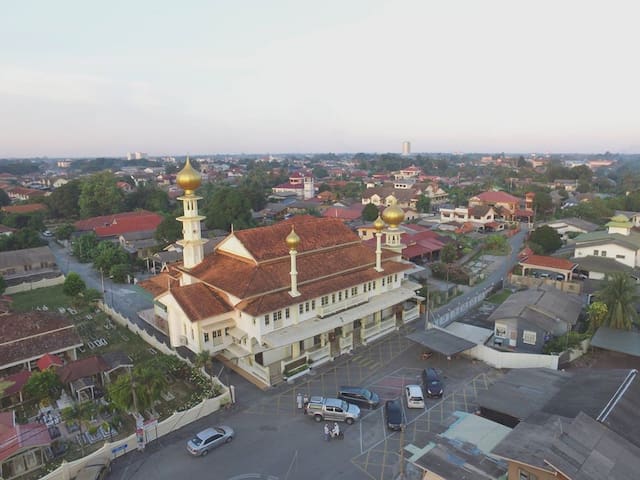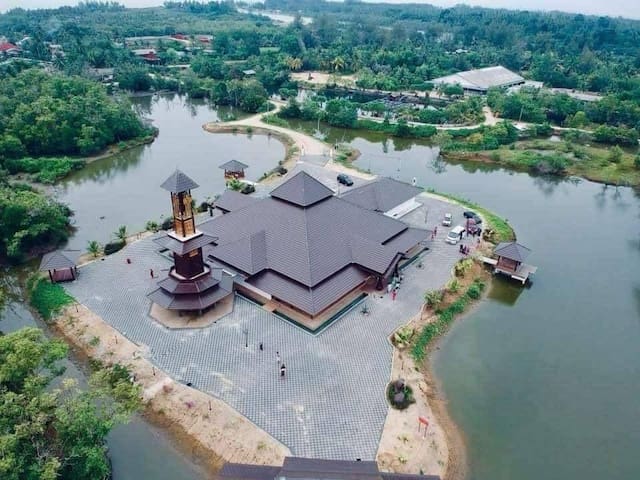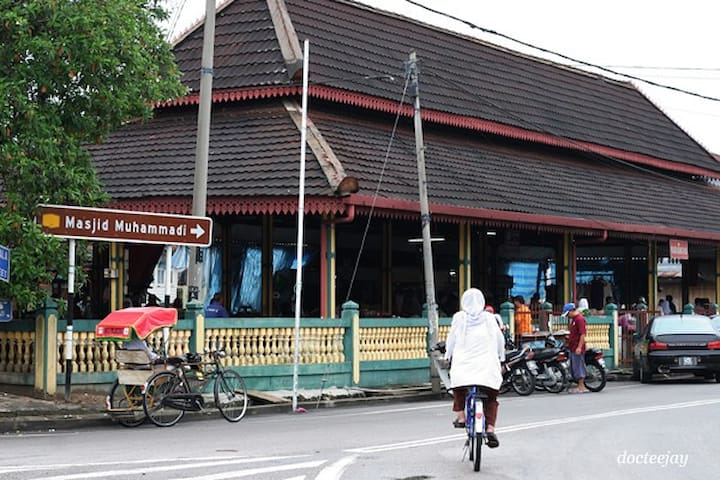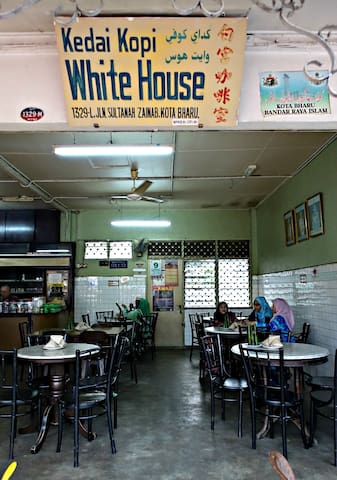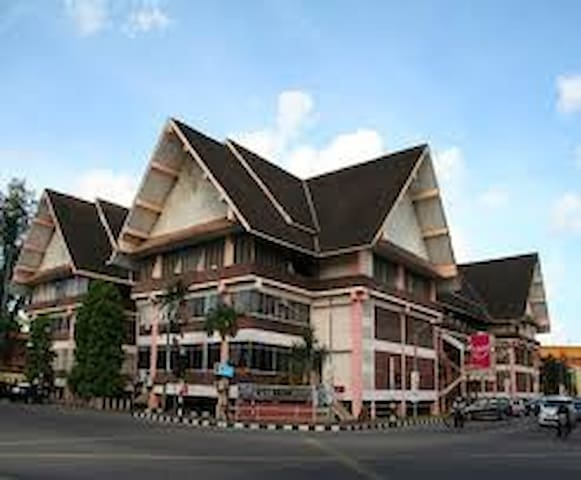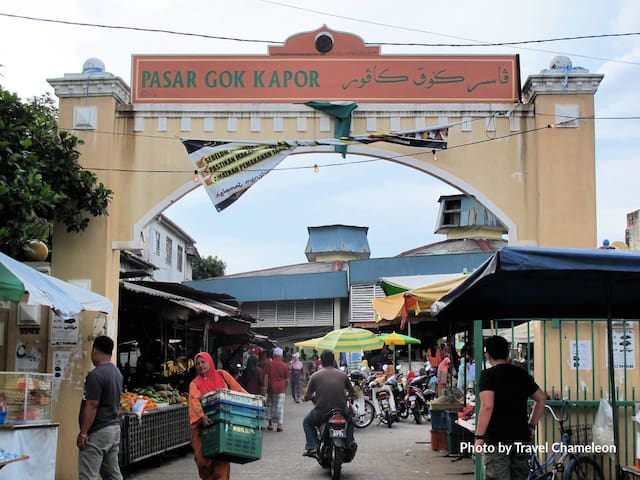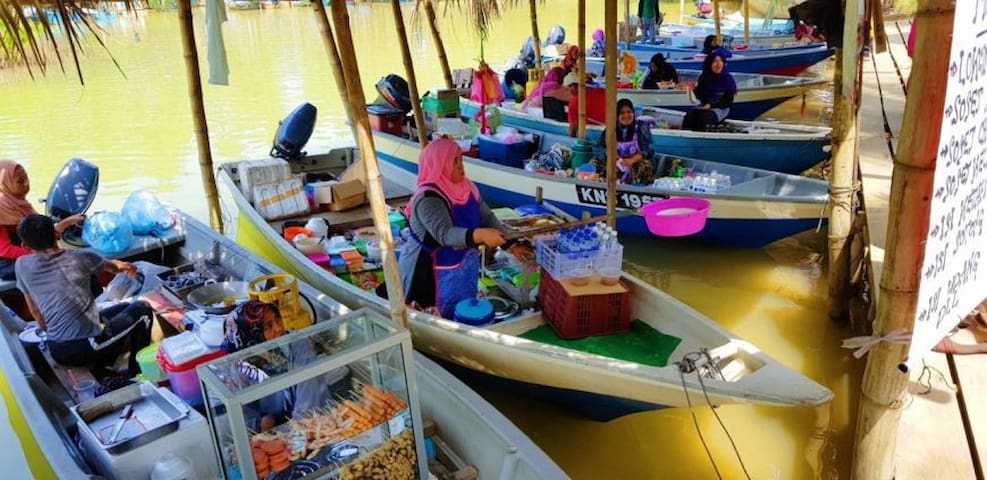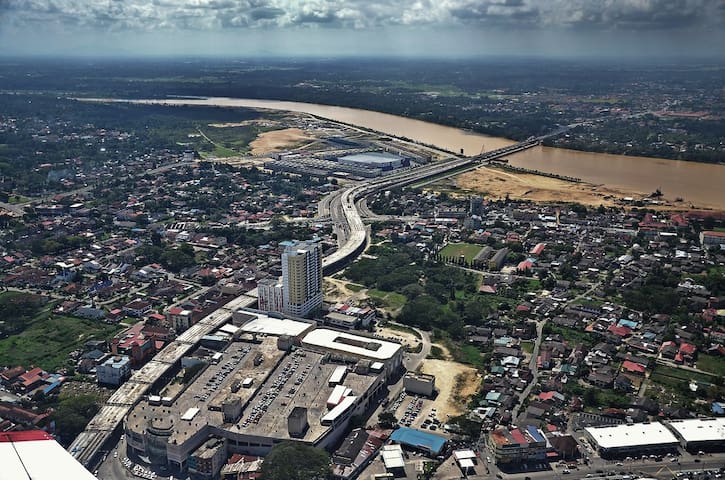Sightseeing
Whether for dawn prayer or early sight seeing. A recommended destination (a mere 3km way from Villa Yusmah) especially given the location that is so convenient with many recommended breakfast joints.
Known originally as Masjid Besar Kota Bharu, the original wooden structure was built in 1867, but replaced with solid concrete structure between 1922 and 1925. Named after the late Sultan Muhammad IV. Further renovations were done on in 1959, 1968, 1976 and 1987.
The mosque adopts an open design concept with a Colonial architectural style, featuring Moghul-style domes and the liberal use of arches and pillars throughout. The main prayer hall is adorned with stunning Roman columns embellished with beautiful dark brown carvings around the top. Air vents along the walls provide natural ventilation in the building.
Masjid Muhammadi is also a renowned Islamic learning centre in the region, particularly among religious scholars and those seeking knowledge of the religion. One of the mosque’s primary functions is to spread the teachings of Islam, earning it the nickname ‘Serambi Mekah’ (Corridor of Mecca). The mosque’s teaching system is similar to that of Masjidil Haram in Mecca. Several prominent Islamic scholars had taught here in the past.
7 locals recommend
Masjid Al-Muhammadi
D1Whether for dawn prayer or early sight seeing. A recommended destination (a mere 3km way from Villa Yusmah) especially given the location that is so convenient with many recommended breakfast joints.
Known originally as Masjid Besar Kota Bharu, the original wooden structure was built in 1867, but replaced with solid concrete structure between 1922 and 1925. Named after the late Sultan Muhammad IV. Further renovations were done on in 1959, 1968, 1976 and 1987.
The mosque adopts an open design concept with a Colonial architectural style, featuring Moghul-style domes and the liberal use of arches and pillars throughout. The main prayer hall is adorned with stunning Roman columns embellished with beautiful dark brown carvings around the top. Air vents along the walls provide natural ventilation in the building.
Masjid Muhammadi is also a renowned Islamic learning centre in the region, particularly among religious scholars and those seeking knowledge of the religion. One of the mosque’s primary functions is to spread the teachings of Islam, earning it the nickname ‘Serambi Mekah’ (Corridor of Mecca). The mosque’s teaching system is similar to that of Masjidil Haram in Mecca. Several prominent Islamic scholars had taught here in the past.
Situated merely 1.1km away from Villa Yusmah, Masjid D'Raja Long Yunus (Long Yunus' Royal Mosque), Langgar was built in the late 1870s. There is a cemetery next to the mosque, dedicated to the Royal Family of Kelantan.
According to history, after the death of Al-Marhum Long Yunus at Pengkalan Galoh, Kg. Sireh, he was buried in a place called "Langgar". The mosque was later built in the name of the cemetery.
The mosque is covered with a three-tiered roof with its "decorative" tops supported by two-layered roofs that are connected to each other, and a cross or "slider/(pemeleh)" placed on the edge of the screen.
This one-storey mosque is almost entirely surrounded by carved wall panels. The walls of the panel surround the mihrab and is the most prominent area in the mosque - dedicated to the Royal Family.
The structure is made of hard concrete supported by concrete columns. The roof tile originated from South China during the time that the state of Kelantan was involved in trade between China and Pattani. The mosque does not have any towers but uses a "beduk" to make announcements or deliver the Azan. The pulpit is said to be the royal throne dedicated to the upper class and carved in a solemn cloud decorative pattern. Looking at the carving pattern and type of wood structure today, there has been no change from the date it was built.
To meet the growing needs of the congregation, the new 3-storey new building was started in January 1985 and completed in July 1987. In 2014 the Langgar Mosque was renamed Masjid D'raja Long Yunus, Langgar.
Masjid DiRaja Long Yunus, Kg. Langgar
Jalan LanggarSituated merely 1.1km away from Villa Yusmah, Masjid D'Raja Long Yunus (Long Yunus' Royal Mosque), Langgar was built in the late 1870s. There is a cemetery next to the mosque, dedicated to the Royal Family of Kelantan.
According to history, after the death of Al-Marhum Long Yunus at Pengkalan Galoh, Kg. Sireh, he was buried in a place called "Langgar". The mosque was later built in the name of the cemetery.
The mosque is covered with a three-tiered roof with its "decorative" tops supported by two-layered roofs that are connected to each other, and a cross or "slider/(pemeleh)" placed on the edge of the screen.
This one-storey mosque is almost entirely surrounded by carved wall panels. The walls of the panel surround the mihrab and is the most prominent area in the mosque - dedicated to the Royal Family.
The structure is made of hard concrete supported by concrete columns. The roof tile originated from South China during the time that the state of Kelantan was involved in trade between China and Pattani. The mosque does not have any towers but uses a "beduk" to make announcements or deliver the Azan. The pulpit is said to be the royal throne dedicated to the upper class and carved in a solemn cloud decorative pattern. Looking at the carving pattern and type of wood structure today, there has been no change from the date it was built.
To meet the growing needs of the congregation, the new 3-storey new building was started in January 1985 and completed in July 1987. In 2014 the Langgar Mosque was renamed Masjid D'raja Long Yunus, Langgar.
Situated 17km away from Villa Yusmah, the Ar-Rahman Mosque was built in early 2016 to meet the growing needs of the congregation, replacing the old Pulau Gajah mosque.
The construction of the 0.8-hectare mosque took two years and can accommodate about 1,000 congregants at a time.
The construction cost of over RM6 million was donated by an undisclosed individual, who also donated the land and designed the mosque.
The design of Ar-Rahman mosque was based on a style combination from at least four countries, in addition to Malay architecture. Two doors of the mosque were from Yemen, the pillar of prayer was from Morocco, the set of stools from Indonesia and the Quranic sketch in the middle of the ceiling was brought in from Turkey. 10 Indonesian artisans produced more than 90 percent of the hand carvings at the mosque, half of which are engraved Quranic verses.
The wooden door, filled with engraved Quranic verses is hundreds of years old and was brought in from Morocco.
Masjid Ar-Rahman Mukim Pulau Gajah
Kampung Pulau GajahSituated 17km away from Villa Yusmah, the Ar-Rahman Mosque was built in early 2016 to meet the growing needs of the congregation, replacing the old Pulau Gajah mosque.
The construction of the 0.8-hectare mosque took two years and can accommodate about 1,000 congregants at a time.
The construction cost of over RM6 million was donated by an undisclosed individual, who also donated the land and designed the mosque.
The design of Ar-Rahman mosque was based on a style combination from at least four countries, in addition to Malay architecture. Two doors of the mosque were from Yemen, the pillar of prayer was from Morocco, the set of stools from Indonesia and the Quranic sketch in the middle of the ceiling was brought in from Turkey. 10 Indonesian artisans produced more than 90 percent of the hand carvings at the mosque, half of which are engraved Quranic verses.
The wooden door, filled with engraved Quranic verses is hundreds of years old and was brought in from Morocco.
Kampung Laut Mosque is the oldest surviving mosque in Malaysia, dating back to around the early 18th century, with references to it being originally built in the 1400s. Its current location is in Nilam Puri, about 11km away from Villa Yusmah.
Built in the 15th century by a group of Champa government transporters from the Kingdom of Champa. Its style is largely typical of local traditional architecture, and is climate-appropriate, similar to local houses in the area. The original mosque had a basic architectural style and structure, with four pillars for the foundation and palm fronds for the roof.
By virtue of architectural resemblance, it is said that the mosque was the original Masjid Agung Demak that was built in 1401. The mosque was relocated from its original site to Kampung Laut, hence the name.
During the reign of the Sultan of Kelantan between 1859 and 1900, the mosque became an important meeting point for the Sultans and religious leaders. The mosque was also used as a trading post. During this period, the mosque was expanded and upgraded with 20 pillars, a three-tiered roof, a tower for muezzin to call for prayers, an attic, and a water tank while the flooring was made of well quality timber.
It has survived two big floods, the first was in 1926 by a flood known as Bah Air Merah and another in 1966. The second flood severely damaged the Mosque when parts of the mosque close to the river were swept away by flood waters.
Since then the mosque has again been relocated to its present location.
Masjid Kampung Laut
Jalan Tok NekKampung Laut Mosque is the oldest surviving mosque in Malaysia, dating back to around the early 18th century, with references to it being originally built in the 1400s. Its current location is in Nilam Puri, about 11km away from Villa Yusmah.
Built in the 15th century by a group of Champa government transporters from the Kingdom of Champa. Its style is largely typical of local traditional architecture, and is climate-appropriate, similar to local houses in the area. The original mosque had a basic architectural style and structure, with four pillars for the foundation and palm fronds for the roof.
By virtue of architectural resemblance, it is said that the mosque was the original Masjid Agung Demak that was built in 1401. The mosque was relocated from its original site to Kampung Laut, hence the name.
During the reign of the Sultan of Kelantan between 1859 and 1900, the mosque became an important meeting point for the Sultans and religious leaders. The mosque was also used as a trading post. During this period, the mosque was expanded and upgraded with 20 pillars, a three-tiered roof, a tower for muezzin to call for prayers, an attic, and a water tank while the flooring was made of well quality timber.
It has survived two big floods, the first was in 1926 by a flood known as Bah Air Merah and another in 1966. The second flood severely damaged the Mosque when parts of the mosque close to the river were swept away by flood waters.
Since then the mosque has again been relocated to its present location.
This colourful display of street art covers several connecting back alleys between Jalan Ismail and Jalan Dato Pati.
6 locals recommend
Street Art Kota Bharu
3631 Jalan Dato PatiThis colourful display of street art covers several connecting back alleys between Jalan Ismail and Jalan Dato Pati.
Also known as the "Balai Getam Guri", this handicraft village and handicraft museum are located in the cultural zone of Kota Bharu, within walking distance from the Istana Balai Besar and Bazar Buluh Kubu.
Muzium Kraftangan houses many of Kelantan's fine handicrafts. Adjacent to the Kampung Kraftangan, there is a place for visitors to see how the handicrafts are produced; traditional embroidery demonstrations, songket weaving, batik 'canting', silver work and wood carving are done by skilled craftsmen. The products produced are also sold here.
The museum is open from 8.30am - 4.45pm daily (except Friday).
Kampung Kraftangan
Also known as the "Balai Getam Guri", this handicraft village and handicraft museum are located in the cultural zone of Kota Bharu, within walking distance from the Istana Balai Besar and Bazar Buluh Kubu.
Muzium Kraftangan houses many of Kelantan's fine handicrafts. Adjacent to the Kampung Kraftangan, there is a place for visitors to see how the handicrafts are produced; traditional embroidery demonstrations, songket weaving, batik 'canting', silver work and wood carving are done by skilled craftsmen. The products produced are also sold here.
The museum is open from 8.30am - 4.45pm daily (except Friday).
Food scene
One of the top picks by locals for breakfast, for generations, is Pasar Kubang Pasu - a walking distance from Masjid Muhammadi and a mere 4km away from Villa Yusmah.
WIth the widest choice of Kelantanese breakfast (nasi belauk, nasi dagang, nasi kerabu, nasi kerabu tumis, nasi impit dan satay, pulut pagi, the legendary nasi tumpang and the list goes on and on - not counting scores of types of kuih-muih). Have it on site or for take away.
A visit to Kota Bharu is not complete until you have breakfast from Pasar Kubang Pasu.
Pasar Kubang Pasu
D1One of the top picks by locals for breakfast, for generations, is Pasar Kubang Pasu - a walking distance from Masjid Muhammadi and a mere 4km away from Villa Yusmah.
WIth the widest choice of Kelantanese breakfast (nasi belauk, nasi dagang, nasi kerabu, nasi kerabu tumis, nasi impit dan satay, pulut pagi, the legendary nasi tumpang and the list goes on and on - not counting scores of types of kuih-muih). Have it on site or for take away.
A visit to Kota Bharu is not complete until you have breakfast from Pasar Kubang Pasu.
Another one on the top of the most popular breakfast haunts in Kota Bharu is Kedai Kopi White House, located opposite of Masjid Muhammadi (4km from Villa Yusmah). The Hainanese coffeeshop started way back in 1935, and moved to its current location in 1980. The current owner is the son-in-law of its founder.
Started as a Hainanese coffeeshop with roti bakar and half boiled eggs, it also serves local Kelantanese packed breakfasts such as nasi kerabu, nasi belauk, nasi dagang, nasi tumpang etc.
White House in Kota Bharu is an institution, so popular among locals and tourists that even before the place opens at 8am, there is already a queue at the door. Everyone in KB comes here for their fix of old school coffee and kaya toast. The place is old, and it looks it, too. But don't for one second think that's a bad thing. Nostalgia is a huge part of the appeal of White House. All the retro trinkets and signs bring you back to days gone by. This coffee shop also happens to receive frequent visits by the Kelantan Royal family.
White House Kopitiam
1329-L Jln Sultanah ZainabAnother one on the top of the most popular breakfast haunts in Kota Bharu is Kedai Kopi White House, located opposite of Masjid Muhammadi (4km from Villa Yusmah). The Hainanese coffeeshop started way back in 1935, and moved to its current location in 1980. The current owner is the son-in-law of its founder.
Started as a Hainanese coffeeshop with roti bakar and half boiled eggs, it also serves local Kelantanese packed breakfasts such as nasi kerabu, nasi belauk, nasi dagang, nasi tumpang etc.
White House in Kota Bharu is an institution, so popular among locals and tourists that even before the place opens at 8am, there is already a queue at the door. Everyone in KB comes here for their fix of old school coffee and kaya toast. The place is old, and it looks it, too. But don't for one second think that's a bad thing. Nostalgia is a huge part of the appeal of White House. All the retro trinkets and signs bring you back to days gone by. This coffee shop also happens to receive frequent visits by the Kelantan Royal family.
A mouth watering sensational breakfast joint located a mere 3.4km away from Villa Yusmah. Serves the traditional Nasi Kerabu Tumis and comes with 'freshly grilled in the open' kambing bakar, daging bakar, ayam bakar etc. Many other side dishes including the Kelantanese Solok Lada for you to savour.
Lieniey Nasi Kerabu Tumis
Jalan Abdul Kadir AdabiA mouth watering sensational breakfast joint located a mere 3.4km away from Villa Yusmah. Serves the traditional Nasi Kerabu Tumis and comes with 'freshly grilled in the open' kambing bakar, daging bakar, ayam bakar etc. Many other side dishes including the Kelantanese Solok Lada for you to savour.
Kelantanese breakfast in comfort. If your choice is a proper restaurant sit in with air-conditioned and open air sections, Restoran Wau (3.4km from Villa Yusma) is definitely an option. The menu has plenty of choices, the dishes are well presented and service is reasonably attentive.
Restoran Wau
Jalan Tg. Petra SemerakKelantanese breakfast in comfort. If your choice is a proper restaurant sit in with air-conditioned and open air sections, Restoran Wau (3.4km from Villa Yusma) is definitely an option. The menu has plenty of choices, the dishes are well presented and service is reasonably attentive.
Local Shopping
Located 3km away from Villa Yusmah, Pasar Siti Khadijah was opened in 1985 to replace the old Pasar Besar Kota Bharu. It was renamed as a tribute to 'women', as the majority of its traders are women.
The market is housed in a 4-storey building and features an octagonal shape. The building is filled with vegetables, fruits, sea food, poultry and meat, local delicacies (such as keropok, keropok lekor, serunding), textiles and brassware. Crowded but with a nice peaceful vibe just like the rest of Kota Bharu. Antiques, gold jewelleries and souvenirs stalls can be seen at the entrance and eateries on the top floor.
An iconic 'ladies market' that is a must see. A visual extravaganza - from all floors - start with ground then get views from floors 1 and 2 - great architecture and people scenes.
45 locals recommend
Siti Khadijah Market, Kota Bharu, Kelantan.
Jalan Buluh KubuLocated 3km away from Villa Yusmah, Pasar Siti Khadijah was opened in 1985 to replace the old Pasar Besar Kota Bharu. It was renamed as a tribute to 'women', as the majority of its traders are women.
The market is housed in a 4-storey building and features an octagonal shape. The building is filled with vegetables, fruits, sea food, poultry and meat, local delicacies (such as keropok, keropok lekor, serunding), textiles and brassware. Crowded but with a nice peaceful vibe just like the rest of Kota Bharu. Antiques, gold jewelleries and souvenirs stalls can be seen at the entrance and eateries on the top floor.
An iconic 'ladies market' that is a must see. A visual extravaganza - from all floors - start with ground then get views from floors 1 and 2 - great architecture and people scenes.
Visiting this three-storey shopping complex is a must for those who love shopping and handicrafts. Here, visitors can purchase handicrafts such as handmade shoes, replica musical instruments, colourful kites (wau), bags, pewter, accessories and many other types of goods - of course not forgetting the ever famous batik and songket. Prices are reasonable and is one of the reasons that make this bazaar very popular among the locals as well as foreign travelers.
7 locals recommend
Bazar Buluh Kubu
Laluan Pasar Karat Kota BharuVisiting this three-storey shopping complex is a must for those who love shopping and handicrafts. Here, visitors can purchase handicrafts such as handmade shoes, replica musical instruments, colourful kites (wau), bags, pewter, accessories and many other types of goods - of course not forgetting the ever famous batik and songket. Prices are reasonable and is one of the reasons that make this bazaar very popular among the locals as well as foreign travelers.
Located in the heart of Kota Bharu City Center, not more than 200m from Gelanggang Seni (Cultural Center) and Kelantan State Public Library, about 1.5km from Villa Yusmah.
The architectural design is based on Islamic concept and local traditional arts. The design of the building consists of domes (which are normally found on mosques), and its main entrance archway was based on Madinah mosque.
Most traders in Bazaar Tok Guru focus on fabric products, such as tudung bawal asli, kain sembahyang, kain batik, kain ela, kain sarung, kain pelikat, etc. There are also a number of sundry shops selling snacks or drinks for the kids while shopping. On the top floor, there is a food court. Lately, the state government has taken initiative to place Kota Bharu Art Market on the second floor of Bazaar Tok Guru.
Bazaar Tok Guru is considered a shopping heaven for ladies shopping for fabrics.
10 locals recommend
Bazar Tok Guru
3 Jln Sultan IbrahimLocated in the heart of Kota Bharu City Center, not more than 200m from Gelanggang Seni (Cultural Center) and Kelantan State Public Library, about 1.5km from Villa Yusmah.
The architectural design is based on Islamic concept and local traditional arts. The design of the building consists of domes (which are normally found on mosques), and its main entrance archway was based on Madinah mosque.
Most traders in Bazaar Tok Guru focus on fabric products, such as tudung bawal asli, kain sembahyang, kain batik, kain ela, kain sarung, kain pelikat, etc. There are also a number of sundry shops selling snacks or drinks for the kids while shopping. On the top floor, there is a food court. Lately, the state government has taken initiative to place Kota Bharu Art Market on the second floor of Bazaar Tok Guru.
Bazaar Tok Guru is considered a shopping heaven for ladies shopping for fabrics.
The name Pasar Gok Kapur (5km away from Villa Yusmah) originated from the 'kapor' making in the area in the past (and still exists today). The word 'gok' refers to a furnace used to heat the sea-shells used for making 'kapur'.
The market was originally located at the entrance of Gok Kapor Village which leads to the river jetty, which served as the river crossing base across the river to Kg. Palekbang and Kg. Laut.
Pasar Gok Kapur is very well known to the locals for its very fresh (from the jetty) seafood at affordable price. Fresh fish, prawns and crabs and the likes are sourced direct from the fishing jetty of coastal fishermen in Kampung Kuala Besar and Sabak Beach.
The market is also famous for its local traditional kuih-muih (prepared in the traditional methods), fresh fruits, kitchen needs and dried seafood products by local entrepreneurs.
The market operates from 3:00pm in the afternoon until 7:00pm.
Pasar Gok Kapor
The name Pasar Gok Kapur (5km away from Villa Yusmah) originated from the 'kapor' making in the area in the past (and still exists today). The word 'gok' refers to a furnace used to heat the sea-shells used for making 'kapur'.
The market was originally located at the entrance of Gok Kapor Village which leads to the river jetty, which served as the river crossing base across the river to Kg. Palekbang and Kg. Laut.
Pasar Gok Kapur is very well known to the locals for its very fresh (from the jetty) seafood at affordable price. Fresh fish, prawns and crabs and the likes are sourced direct from the fishing jetty of coastal fishermen in Kampung Kuala Besar and Sabak Beach.
The market is also famous for its local traditional kuih-muih (prepared in the traditional methods), fresh fruits, kitchen needs and dried seafood products by local entrepreneurs.
The market operates from 3:00pm in the afternoon until 7:00pm.
Pasar Terapung Pulau Suri (Pulau Suri Floating Market). Traders in boats selling various types of Kelantanese dishes and delicacies such as coconut jelly, gula melaka, honey, nasi belauk, local traditional dishes, nutmeg, kerabu nipah, lokan bakar and the list goes on.
Another attraction or specialty is that the market also offers "River Cruise" packages ranging from RM5 to RM15 per person depending on the types of boat you take to explore the river in Tumpat.
Accessible via boat jetty at Kuala Besar (9km from Villa Yusmah). Opens every Saturday from 8am to 3pm.
Pulau Suri
Pasar Terapung Pulau Suri (Pulau Suri Floating Market). Traders in boats selling various types of Kelantanese dishes and delicacies such as coconut jelly, gula melaka, honey, nasi belauk, local traditional dishes, nutmeg, kerabu nipah, lokan bakar and the list goes on.
Another attraction or specialty is that the market also offers "River Cruise" packages ranging from RM5 to RM15 per person depending on the types of boat you take to explore the river in Tumpat.
Accessible via boat jetty at Kuala Besar (9km from Villa Yusmah). Opens every Saturday from 8am to 3pm.
Pasar Tani Terapung Pengkalan Datu is located 13km from Villa Yusmah operates every Saturday from 8am to 2pm, and is increasingly attracting tourists and locals alike.
In addition to buying the various goods, food and delicacies on sale here at affordable prices, visitors can also try other interesting activities such as sightseeing, fishing, as well as taking a River Cruise to explore the natural panoramas surrounding Pengkalan Datu river.
Visitors can also enjoy their meal at the tables provided at the floating restaurant. The tranquil river views provide a relaxing atmosphere for shopping or for enjoying family meals.
Pasar Tani Terapung - Floating Market
Pasar Tani Terapung Pengkalan Datu is located 13km from Villa Yusmah operates every Saturday from 8am to 2pm, and is increasingly attracting tourists and locals alike.
In addition to buying the various goods, food and delicacies on sale here at affordable prices, visitors can also try other interesting activities such as sightseeing, fishing, as well as taking a River Cruise to explore the natural panoramas surrounding Pengkalan Datu river.
Visitors can also enjoy their meal at the tables provided at the floating restaurant. The tranquil river views provide a relaxing atmosphere for shopping or for enjoying family meals.
Neighborhoods
Welcome to Kota Bharu!
The northernmost major city in Malaysia, Kota Bharu is deeply grounded in traditional Malay heritage. It has all the energy of a midsized city with the compact feel and friendly vibe of a small town combined with a rich history, great local cuisine and the perfect place to discover the culture of Malaysia. There are excellent markets and more than ample opportunities to taste superb local cuisine.
Kota Bharu
Welcome to Kota Bharu!
The northernmost major city in Malaysia, Kota Bharu is deeply grounded in traditional Malay heritage. It has all the energy of a midsized city with the compact feel and friendly vibe of a small town combined with a rich history, great local cuisine and the perfect place to discover the culture of Malaysia. There are excellent markets and more than ample opportunities to taste superb local cuisine.
City advice
Don't miss
Other things to do in Kota Bharu
Other attractions include:
The Cultural Centre performances: At 3.30pm on a Monday, Wednesday, or Saturday head to the Cultural Center for an immersive experience.
The central market in the heart of the city: Another one of the favourite things in Kota Bharu, everything is so colourful.
Islamic Museum: A good 40 minutes of learning about the Islamic culture in Malaysia.
The sitting Buddha at Machimmaram Temple: This is the largest sitting Buddha in Malaysia. It makes sense that it’s here given the cities location next to Thailand, but Kelantan is very conservative so it does stand out.


